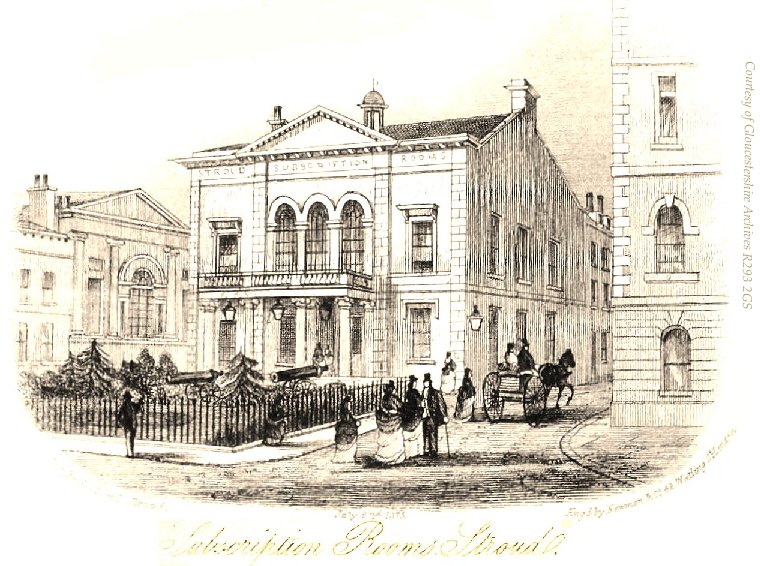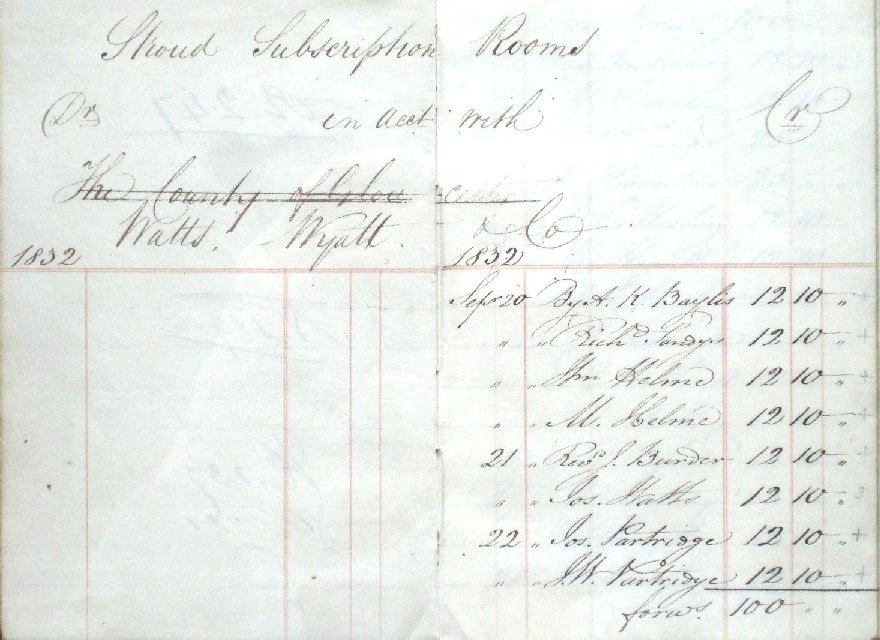In March 2014, Stroud Local History Society was invited to take part in a Tourism Day organised by the staff of the Tourist Office at Stroud Subscription Rooms. Members contributed to a display that included a short slideshow I had quickly put together about the early days of the Rooms. The SLHS Chairman, Howard Beard, came to find me after the exhibition and asked "Did you know that I have the original bank book for the Subscribers?". Well no, I didn't. Howard's collection of ephemera had already contributed to earlier research into The Field estate of William Cowle, and he was happy to lend the account book so that I could take a close look. The manager of the Subscription Rooms was very interested because he had never been able to find a proper history of the building and asked what else we might have. This was the start of a year's research into the origins of the Subscription Rooms that culminated in the publication of a book.
The Reform Act of 1832 made Stroud into a Borough and gave its inhabitants (or some of them) the right to elect two Members of Parliament instead of one. The local gentry decided the town’s new status should be marked by the erection of an impressive public building. One of the hopeful candidates for Parliament was William Henry Hyett, of Painswick, whose wife's brother-in-law was an ambitious young London architect called George Basevi (later to design some of London's iconic Squares, and die from a fall from Ely cathedral's lantern). William Hyett persuaded his brother-in-law to draw up plans, at no cost to the town, and a move began to attract Subscriptions of £50 a share towards the cost of the new building and the site for its construction.
This engraving, dated 2nd July 1875, was published by J G Pond in a booklet of Local Views. It shows the portico and balcony that was added in 1869 to allow visitors to get out of their carriages and into the building without getting rained on.

Howard's bank book contains the names of all the men who subscribed to the building fund (you can drill down here for a list of the original subscribers) and of the local tradesmen who were paid to do the work. Here is the first page:

Watts was Joseph Watts, owner of the Stroud Brewery, and Stratford Park. Wyatt was Richard Wyatt, a Stroud solicitor. Both were partners in a private bank in town. The subscription fund was launched and local gentry and tradesmen started to buy shares. Most of them paid in instalments and within a year £500 had been raised.
By a nice coincidence, a piece of land in the town centre was available and the Trustees of the new fund paid £420 to acquire it. They commissioned a local builder, Charles Harrison, to do the work and appointed Charles Baker, a surveyor and architect from Painswick, to supervise the project. By the time the Subscription closed in June 1835 a total of £3,380 had been raised, which was almost enough to pay all the bills. A quick whipround raised another £317 in loans to pay for the final touches.
By another nice coincidence, Stroud's prolific diarist Paul Hawkins Fisher had mentioned many events at 'the Rooms', and the Share Register and early contracts were safely stored in Richard Wyatt's unsorted boxes of papers stored at Gloucestershire Archives. Together with the bank book, these primary sources provided the basis for a good story. Another diary surfaced in the SLHS's own archive. And it was one of Stroud's early MPs - Lord John Russell - who introduced a new Reform Bill when he was Prime Minister that enfranchised a much wider range of the town's residents, which pleased Liberal Stroud, although there were many noisy political arguments in the Rooms.
Other nice surprises followed - including the present location of a Crimean war small cannon that had been donated to the Rooms in 1856. And one of SLHS's members had been to the Sub Rooms as a schoolboy, during WW2, when the Rooms provided a community centre for service-men on leave, and munitions workers billeted around the town - and for schoolboys who liked to play table tennis and dance to music on the record player, so that story is in the book too.
The Rooms went through a number of financial crises, and refurbishments, and a major change of ownership in 1926. By 1961 the whole building was in a sorry state and was bought by Stroud District Council for £12,000. Once more, the Rooms became the venue for exhibitions, concerts, meetings, bazaars and visiting entertainers. The cannon and railings are long gone and the Reading Room is no longer there; the room is now used as the town's Tourist Office.
The story of the founding and funding of the Rooms, its financial ups and downs, and highlights from the first 120 years is in my book, published by and for Stroud Local History Society and available for £5 in local bookshops or by email from books@stroudlocalhistorysociety.org.uk
.If you are a local or academic historian and would like to browse through the archive of background documents used in this research project you can do so using this link: History of Stroud Subscription Rooms. Our research is available for personal and academic use under a Creative Commons 4.0 license.
(If you are not already familiar with this copyright system, clicking this CC button  will take you to an explanation of the scheme, and its very simple fair use terms.)
will take you to an explanation of the scheme, and its very simple fair use terms.)
The archive includes:
- a timeline for the building and list of documentary sources
- background information on the early key players
- a summary of the bank book and who paid, or was paid, what
- a summary of the Wyatt papers at Gloucestershire Archives
- extracts from books by contemporary historians Paul Hawkins Fisher and John Libby
- extracts from local diaries
- all the pages from the first bank book
- copies of the trade accounts and old postcards, very kindly included by Howard Beard
- poster panels designed for the book launch illustrating events at the Rooms for which pamphlets or programmes survive in local archives.
The Stroud Local Society website is a good place to start if you want to find out more about Stroud's people and places.
Marion Hearfield, February 2015
